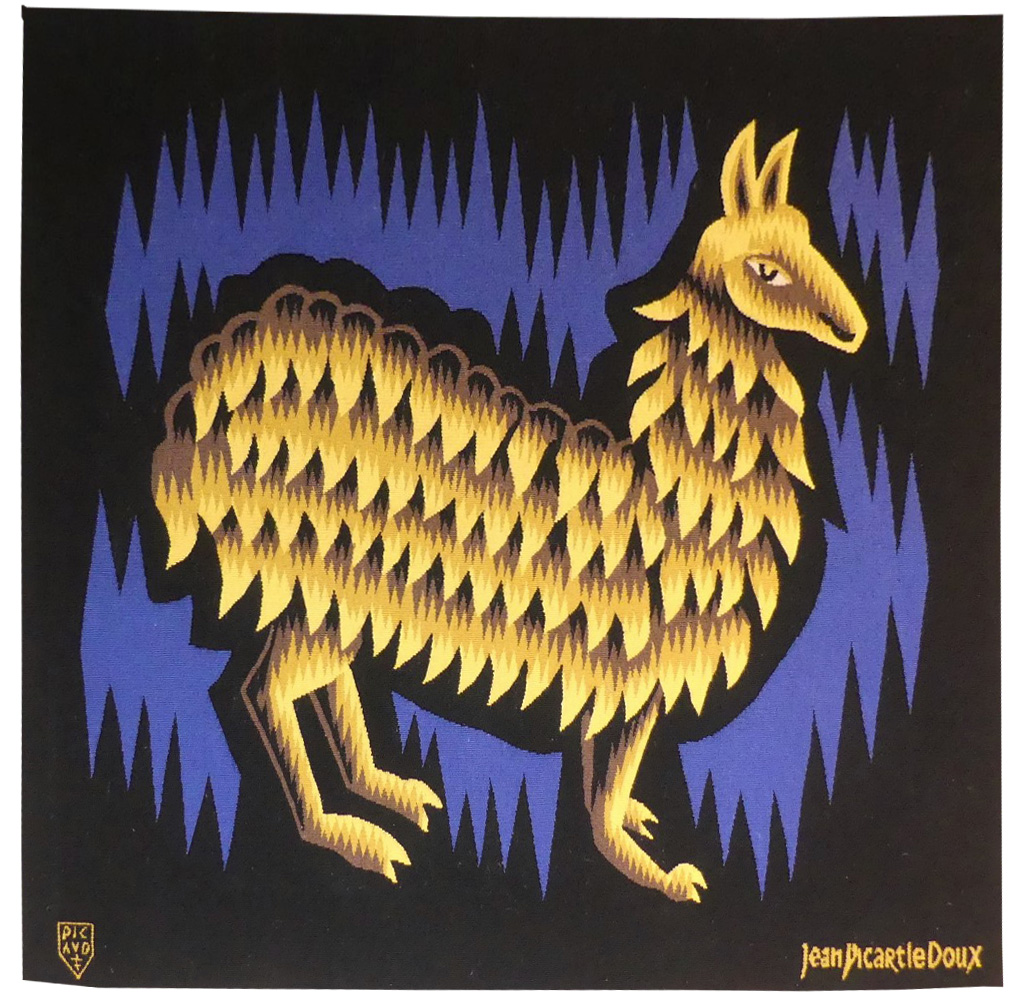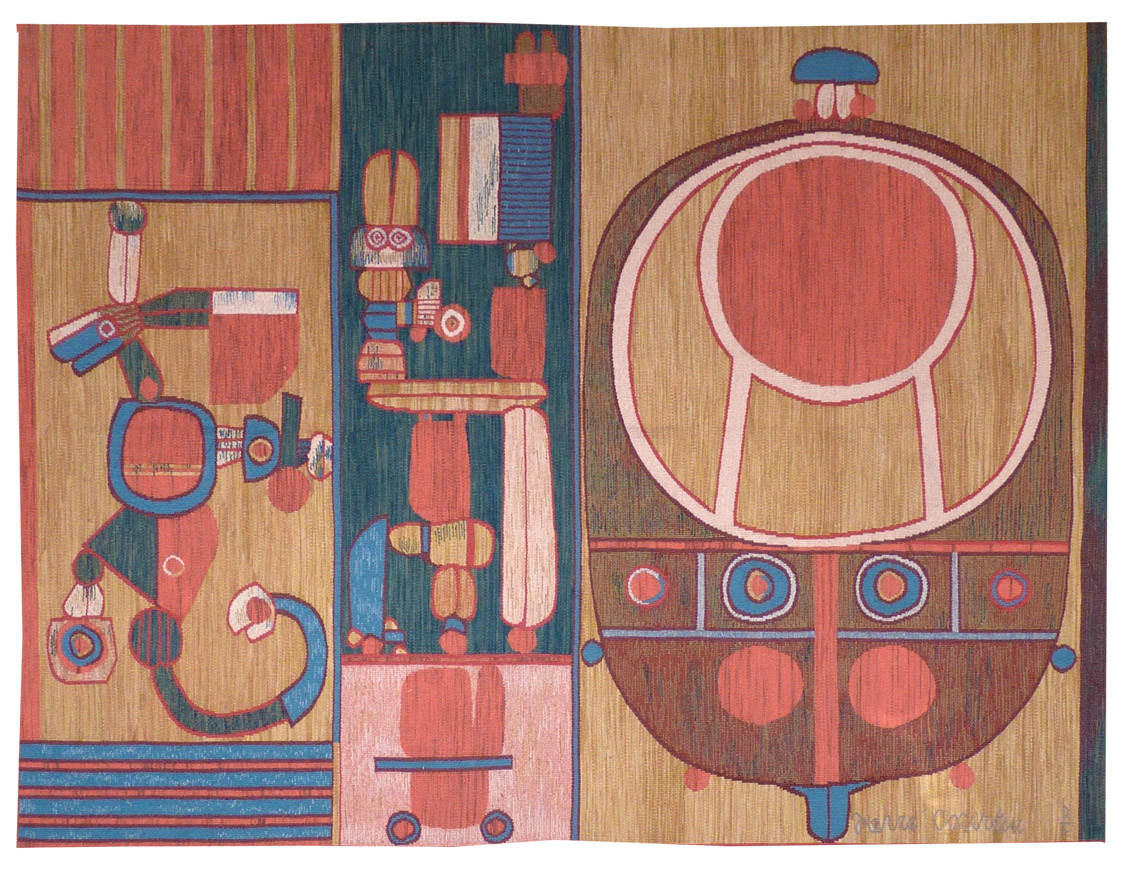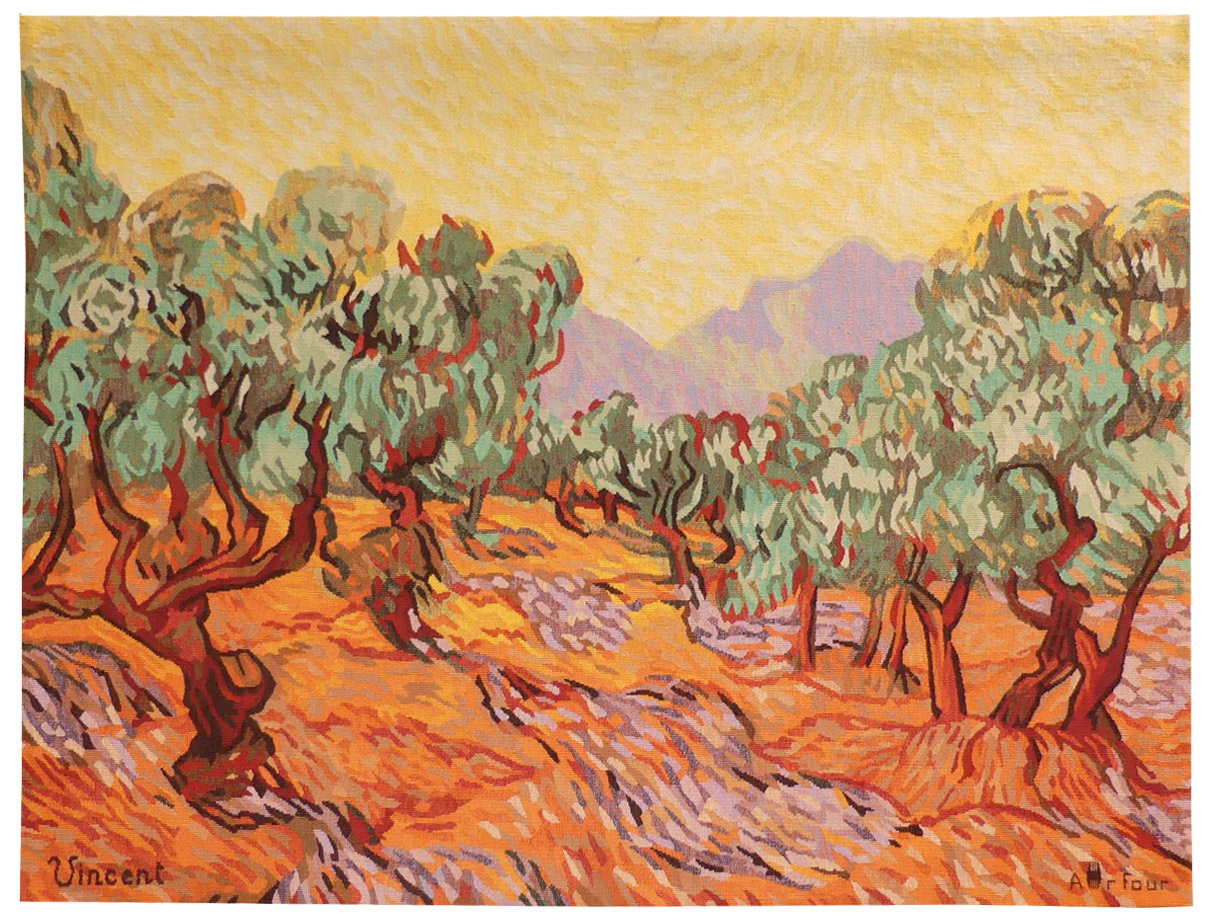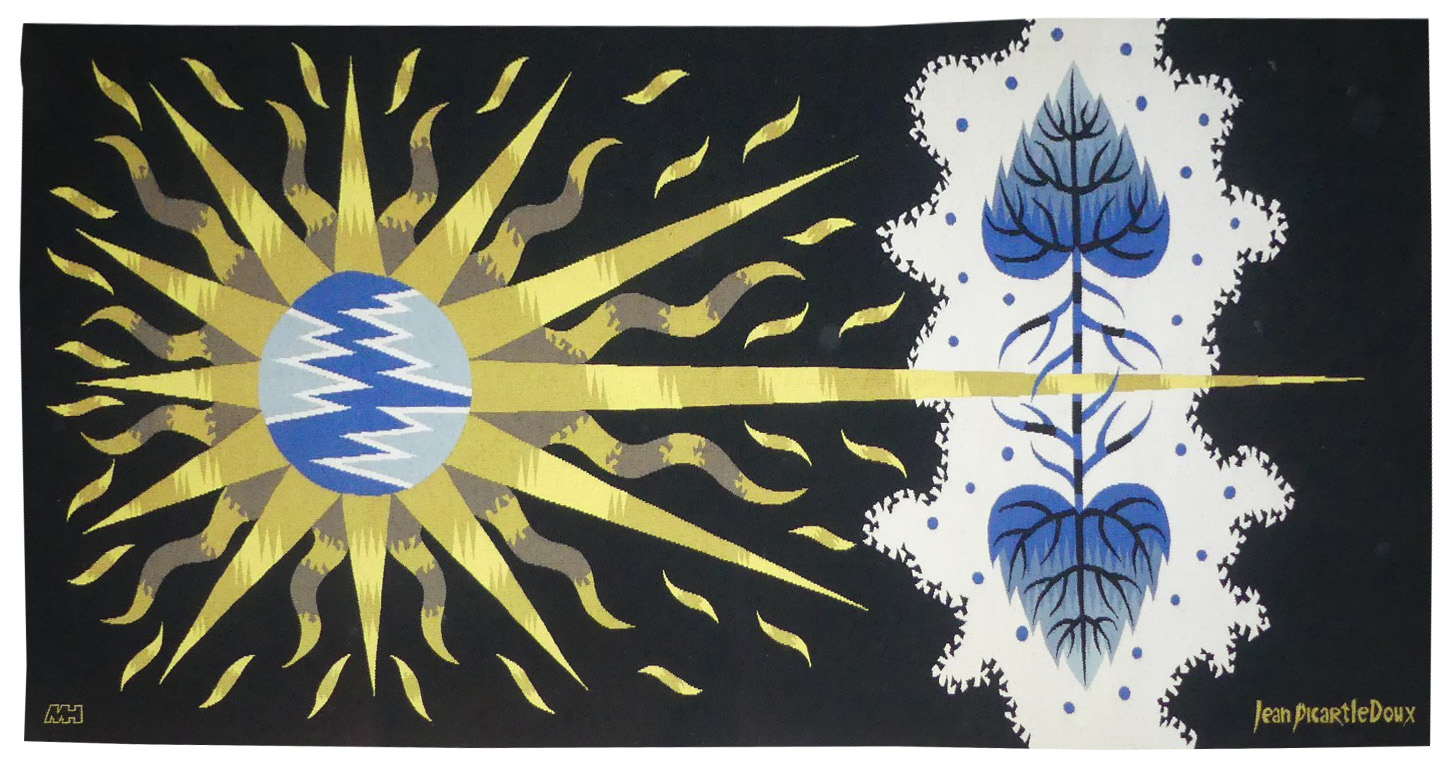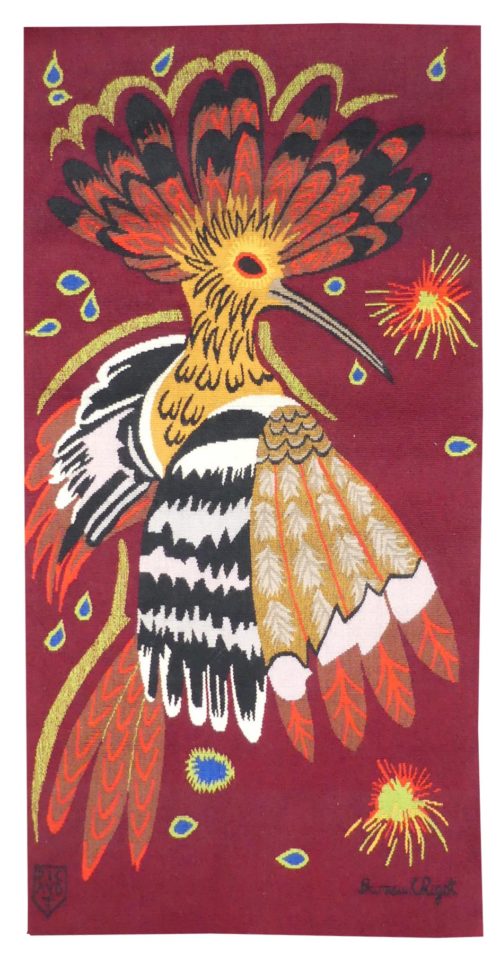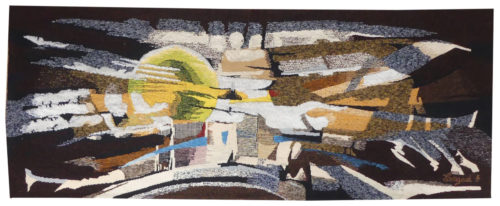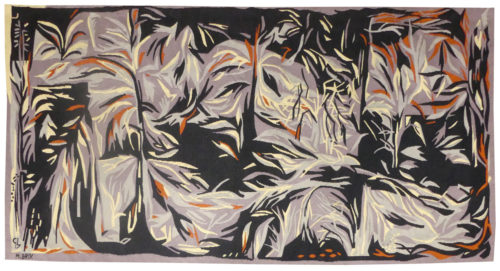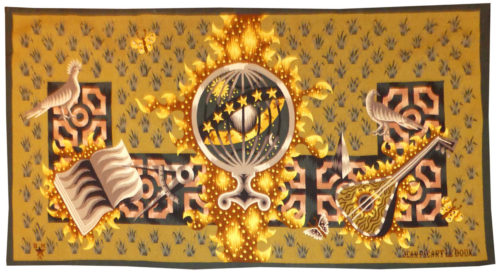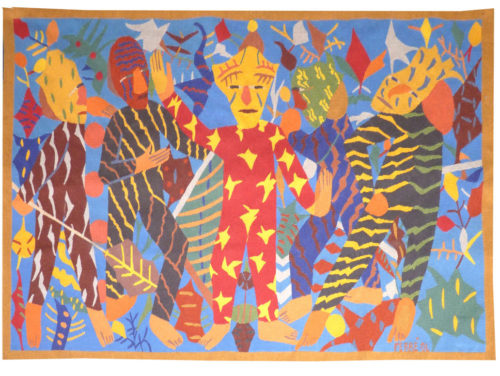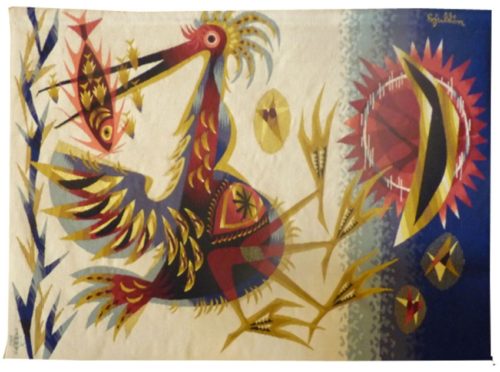-
La vérité cruelle d'un ancien jeu (the crual truth of an old game)
Aubusson tapestry woven in the Pinton workshop. With label. 1970. Best known as an engraver (and, be it said, one of the most important of the XXth century), Pierre Courtin designed several tapestry cartoons (of which one measuring 110m2 (!) is to be seen at the International Labour Organization in Geneva), some of which, like ours, are taken from his engravings.. In this piece, the particular and personal aesthetic of the artist is revealed in the original grouping together of geometrical forms, which can be seen as a little reminiscent of ancient civilisations (pre-columbian particularly). Strange also the choice of colour scheme of this artist, who distances himself from the strong colour contrasts characteristic of his colleagues. -
The Four workshop produced a certain number of hand-woven tapestries which depicted works of the great masters : thus Klee, Modigliani, Macke or, as here, Van Gogh are faithfully reproduced in wool that reflects the shading and brushstrokes of the artist’s original.Aubusson tapestry woven by the Four workshop. With label, n°6/6. After a painting by the artist, produced in 1889, in the Minneapolis Institute of Arts.
-
Composition
Aubusson tapestry woven in the Henry workshop. With signed label, n°1/1. 1984.Like other sculptors (Gilioli, Adam, Ubac...), Hairabédian turned to tapestry (his studio was located in Creuse from 1975 to 1985). In the absence of volume, his spectacular composition plays on the size of weaving stitches, the hollowing out of space with the blank warp... processes typical of the ‘New Tapestry’. -
Germination
Aubusson tapestry woven by the Henry workshop. With signed label, n°2/6. Circa 1980. Jean Picart le Doux is one of the foremost figures in the renaissance of the art of tapestry. His earliest contributions to the field date back to 1943 when he designed cartoons for the passenger ship “la Marseillaise”. A close associate of Lurçat, whose theories he would adopt (limited palette, numbered cartoons...), he was a founding member of the A.P.C.T. (Association des Peintres-cartonniers de Tapisserie), and soon after, a teacher at the Ecole Nationale Supérieure des Arts Décoratifs. The state gave him several commissions most of them at the Aubusson workshop, and some at the Gobelins : the most spectacular of these being for the University of Caen, the Theatre in Le Mans, the passenger ship France or the Prefecture of the Creuse département ... In as much as Picart le Doux’s aesthetic is close to that of Lurçat, so also is his inspiration and his subject matter, although in a register which is more decorative than symbolic, where he brings together heavenly bodies (the sun, the moon, the stars...), the elements, nature (wheat, vines, fish, birds...), man, literary quotation ... The association of two elements is extremely common in the work of Picart le Doux : it allows for the complementary presentation of two elements day/night , sea/sky, land/sea…. In the association presented here we see Nature as one and unified, the sun warms the plant and thus produces « Germination » Bibliography : Marthe Belle-Joufray, Jean Picart le Doux, Publications filmées d’art et d’histoire, 1966 Maurice Bruzeau, Jean Picart le Doux, Murs de soleil, Editions Cercle d’art, 1972 Exhibition Catalogue, Jean Picart le Doux, tapisseries, Musée de Saint-Denis, 1976 Exhibition Catalogue Jean Picart le Doux, Musée de la Poste, 1980 -
La huppe rouge (the red hoopooe)
Aubusson tapestry woven by the Picaud workshop. With signed label, n°3/6. Circa 1970.Originally from the Limousin region of France (and the daughter of the master glass-blower François Chigot), Delphine Bureau-Chigot devoted a large part of her creative energies (she was also a painter and a pastel artist) to tapestry design (something over a hundred) which were for the most part woven by the Picaud workshop, often evoking a dream-like world where animals (and notably birds) had an important place. -
Ville (city)
A former student at the ENAD in Aubusson, Lartigaud created his first tapestry cartoon in 1968. He went on to design hundreds more, most of them woven by the Four Workshop, in an abstract style occasionally studded with celestial bodies.Aubusson tapestry woven in the Four workshop. With signed label, n°EA. Circa 1980. -
Rêve gris (Grey dream)
An unreferenced artist, Monique Brix submitted a few tapestry cartoons to Aubusson which were woven by the Glaudin-Brivet or Pinton workshops.Aubusson tapestry woven by the Glaudin-Brivet workshop. With signed label, n°6/6. Circa 1980. -
Sphère et colombes (Sphere and doves)
Aubusson tapestry woven in the Berthaut workshop. Complete with signed label. Circa 1954. Jean Picart le Doux is one of the foremost figures in the renaissance of the art of tapestry. His earliest contributions to the field date back to 1943 when he designed cartoons for the passenger ship “la Marseillaise”. A close associate of Lurçat, whose theories he would adopt (limited palette, numbered cartoons...), he was a founding member of the A.P.C.T. (Association des Peintres-cartonniers de Tapisserie), and soon after, a teacher at the Ecole Nationale Supérieure des Arts Décoratifs. The state gave him several commissions most of them at the Aubusson workshop, and some at the Gobelins : the most spectacular of these being for the University of Caen, the Theatre in Le Mans, the passenger ship France or the Prefecture of the Creuse département ... In as much as Picart le Doux’s aesthetic is close to that of Lurçat, so also is his inspiration and his subject matter, although in a register which is more decorative than symbolic, where he brings together heavenly bodies (the sun, the moon, the stars...), the elements, nature (wheat, vines, fish, birds...), man, literary quotation ... Typical of the associations that characterise his work, Picart le Doux here confronts Nature (organised in a formal French garden style) peopled by doves with 3 allegories : literature (a book) the arts (a mandoline), science (a sphere) : the incarnation of a classical mind. Bibliography : Maurice Bruzeau, Jean Picart le Doux, Murs de soleil, Editions Cercle d’art, 1972 Exhibition Catalogue, Jean Picart le Doux, tapisseries, Musée de Saint-Denis, 1976 Exhibition Catalogue Jean Picart le Doux, Musée de la Poste, 1980 -
Danseuses cambodgiennes (Cambodian dancers)
Tapestry woven at Aubusson by the Picaud workshop. Certificate of origin, n° 1/4. Circa 1965. Although somewhat overlooked now, the contribution that Maurice Ferréol made, in the 1960’s, to the design of figurative tapestry is quite remarkable. He proposed a style redolent of popular imagery where the use of pure blocks of colour exacerbates the almost childlike outline of the figures. What connects these bright and garishly coloured, masked figures to Cambodia? They are simply a pretext for a profusion of colours and motifs in the particular characteristic style of Ferréol. -
Envie et Gourmandise (les pêchés capitaux) (Envy and Gluttony – the seven deadly sins)
Aubusson tapestry woven in the Legoueix workshop. Complete with certificate of origin signed by the artist. 1956. After the traditional completion of some mural paintings in the 1930’s, he then arrived in Aubusson in 1936, became closely associated with Picart le Doux in 1947 and then joined the A.P.C.T. (Association des Peintres-Cartonniers de Tapisserie). From then on he devoted himself to tapestry with zeal and designed 167 cartoons, at first figurative following on from Picart le Doux and Saint-Saëns, then, influenced by the scientific themes that he dealt with, tending more towards abstraction. In 1981, two years before his death, he donated his studio to the Musée départemental de la tapisserie in Aubusson. « He considers… in this short but extremely witty series, the vices and his treatment reveals a malicious sense of humour returning in an original way to a theme much used during the middle ages.” (Exhibition catalogue “Hommage à Louis-Marie Jullien, Aubusson, Musée départemental de la Tapisserie, 1983, p.4) Here the subject is a pretext for the representation of animals such as can be found in the work of his contemporaries, notably Picart le Doux with whom he was closely associated. According to the 1983 exhibition catalogue (which is considered to be the catalogue raisonné and in which this piece appears as number 53), only one tapestry was ever woven from this cartoon: it is thus unique. Bibliography : Exhibition catalogue Hommage à Louis-Marie Jullien, Aubusson, Musée départemental de la Tapisserie, 1983


